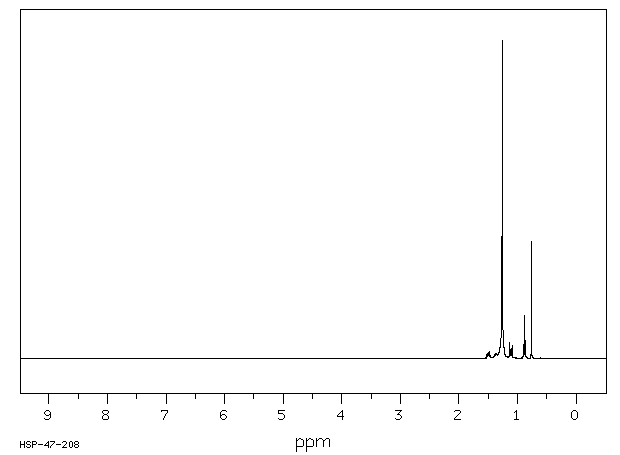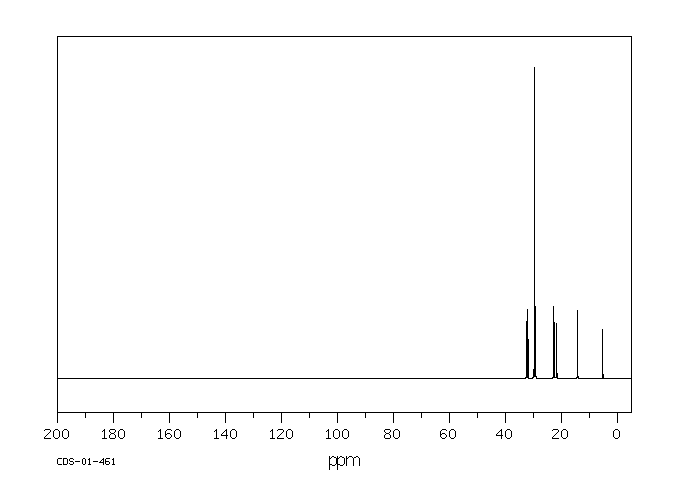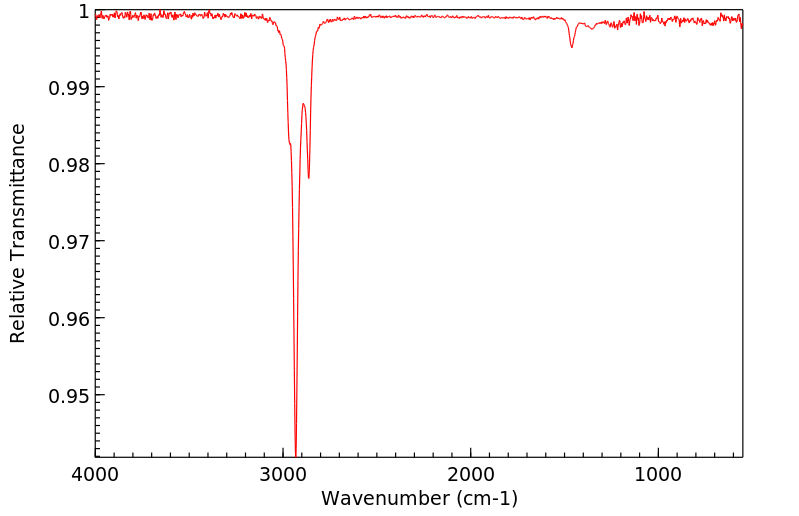甲基十八烷基二氯化硅烷 | 5157-75-5
中文名称
甲基十八烷基二氯化硅烷
中文别名
二氯(甲基)十八烷基硅烷;正十八烷基甲基二氯硅烷;十八甲基二氯硅烷;二氯甲基十八烷基硅烷;甲基十八烷基二氯硅烷
英文名称
n-octadecylmethyldichlorosilane
英文别名
dichloro(methyl)(octadecyl)silane;methyl-n-octadecyldichlorosilane;dichloro(methyl)octadecylsilane;octadecyldichloro(methyl)silane;octadecylmethyldichlorosilane;me(od)SiCl2;Dichloromethyloctadecylsilane;dichloro-methyl-octadecylsilane
CAS
5157-75-5
化学式
C19H40Cl2Si
mdl
——
分子量
367.518
InChiKey
GYWBHBXGYTYXRG-UHFFFAOYSA-N
BEILSTEIN
——
EINECS
——
-
物化性质
-
计算性质
-
ADMET
-
安全信息
-
SDS
-
制备方法与用途
-
上下游信息
-
文献信息
-
表征谱图
-
同类化合物
-
相关功能分类
-
相关结构分类
物化性质
-
熔点:~25 °C(lit.)
-
沸点:185 °C2.5 mm Hg(lit.)
-
密度:0.92 g/mL at 20 °C(lit.)
-
闪点:185 °C
-
稳定性/保质期:
在常温常压下保持稳定
计算性质
-
辛醇/水分配系数(LogP):8.8
-
重原子数:22
-
可旋转键数:17
-
环数:0.0
-
sp3杂化的碳原子比例:1.0
-
拓扑面积:0
-
氢给体数:0
-
氢受体数:0
安全信息
-
TSCA:Yes
-
危险等级:8
-
危险品标志:C
-
安全说明:S26,S28,S36/37/39,S45
-
危险类别码:R34
-
WGK Germany:1
-
海关编码:2931900090
-
危险品运输编号:UN 2987 8/PG 2
-
危险标志:GHS05
-
危险性描述:H314
-
危险性防范说明:P280,P305 + P351 + P338,P310
-
储存条件:请将药品存放在避光、阴凉干燥的地方,并密封保存。
SDS
二氯(甲基)十八烷基硅烷 修改号码:6
模块 1. 化学品
产品名称: Dichloro(methyl)octadecylsilane
修改号码: 6
模块 2. 危险性概述
GHS分类
物理性危害
金属腐蚀性 第1级
健康危害
皮肤腐蚀/刺激 1B类
严重损伤/刺激眼睛 第1级
环境危害 未分类
GHS标签元素
图标或危害标志
信号词 危险
危险描述 可能腐蚀金属
造成严重的皮肤灼伤和眼损伤
防范说明
[预防] 只可存放于原用的容器内。
切勿吸入。
处理后要彻底清洗双手。
穿戴防护手套/护目镜/防护面具。
[急救措施] 吸入:将受害者移到新鲜空气处,在呼吸舒适的地方保持休息。
食入:漱口。切勿催吐。
眼睛接触:用水小心清洗几分钟。如果方便,易操作,摘除隐形眼镜。继续冲洗。
皮肤接触:立即去除/脱掉所有被污染的衣物。用水清洗皮肤/淋浴。
被污染的衣物清洗后方可重新使用。
立即呼叫解毒中心/医生。
吸收溢出物,防止材料被损坏。
[储存] 存放处须加锁。
[废弃处置] 根据当地政府规定把物品/容器交与工业废弃处理机构。
二氯(甲基)十八烷基硅烷 修改号码:6
模块 3. 成分/组成信息
单一物质/混和物 单一物质
化学名(中文名): 二氯(甲基)十八烷基硅烷
百分比: >94.0%(GC)
CAS编码: 5157-75-5
俗名: Dichlorooctadecylmethylsilane
分子式: C19H40Cl2Si
模块 4. 急救措施
吸入: 将受害者移到新鲜空气处,保持呼吸通畅,休息。立即呼叫解毒中心/医生。
皮肤接触: 立即去除/脱掉所有被污染的衣物。用大量肥皂和水轻轻洗。
立即呼叫解毒中心/医生。
眼睛接触: 用水小心清洗几分钟。如果方便,易操作,摘除隐形眼镜。继续清洗。
立即呼叫解毒中心/医生。
食入: 立即呼叫解毒中心/医生。漱口。切勿引吐。
紧急救助者的防护: 救援者需要穿戴个人防护用品,比如橡胶手套和气密性护目镜。
模块 5. 消防措施
合适的灭火剂: 干粉,二氧化碳
不适用的灭火剂: 水
特殊危险性: 小心,燃烧或高温下可能分解产生毒烟。
特定方法: 从上风处灭火,根据周围环境选择合适的灭火方法。
非相关人员应该撤离至安全地方。
周围一旦着火:如果安全,移去可移动容器。
消防员的特殊防护用具: 灭火时,一定要穿戴个人防护用品。
模块 6. 泄漏应急处理
个人防护措施,防护用具, 使用特殊的个人防护用品(针对有毒颗粒的P3过滤式空气呼吸器)。远离溢出物/泄露
紧急措施: 处并处在上风处。
泄露区应该用安全带等圈起来,控制非相关人员进入。
环保措施: 防止进入下水道。
控制和清洗的方法和材料: 清扫收集粉尘,封入密闭容器。注意切勿分散。附着物或收集物应该立即根据合适的
法律法规处置。
副危险性的防护措施 切勿与水接触。移除所有火源。一旦发生火灾应该准备灭火器。使用防火花工具和防
爆设备。
模块 7. 操作处置与储存
处理
技术措施: 在通风良好处进行处理。穿戴合适的防护用具。防止粉尘扩散。处理后彻底清洗双手
和脸。
注意事项: 如果可能,使用封闭系统。如果粉尘或浮质产生,使用局部排气。
操作处置注意事项: 避免接触皮肤、眼睛和衣物。
可能产生高压。小心打开。
使用耐腐蚀设备。
贮存
储存条件: 保持容器密闭。存放于凉爽、阴暗处。
存放于惰性气体环境中。
防湿。
存放处须加锁。
远离不相容的材料比如氧化剂存放。
二氯(甲基)十八烷基硅烷 修改号码:6
模块 7. 操作处置与储存
潮敏
包装材料: 依据法律。只可存放在原用的容器內。
模块 8. 接触控制和个体防护
工程控制: 尽可能安装封闭体系或局部排风系统。同时安装淋浴器和洗眼器。
个人防护用品
呼吸系统防护: 防尘面具,自携式呼吸器(SCBA),供气呼吸器等。使用通过政府标准的呼吸器。依
据当地和政府法规。
手部防护: 防渗手套。
眼睛防护: 护目镜。如果情况需要,佩戴面具。
皮肤和身体防护: 防渗防护服。如果情况需要,穿戴防护靴。
模块 9. 理化特性
固体
外形(20°C):
外观: 晶体-块状
颜色: 白色类白色
气味: 无资料
pH: 无数据资料
熔点: 23°C (凝固点)
沸点/沸程 210 °C/0.8kPa
闪点: 无资料
爆炸特性
爆炸下限: 无资料
爆炸上限: 无资料
密度: 无资料
溶解度:
[水] 无资料
[其他溶剂] 无资料
模块 10. 稳定性和反应性
化学稳定性: 一般情况下稳定。
危险反应的可能性: 与水接触分解并产生有毒气体。
避免接触的条件: 湿气
须避免接触的物质 氧化剂, 碱, 水
危险的分解产物: 一氧化碳, 二氧化碳, 氯化氢, 氧化硅
模块 11. 毒理学信息
急性毒性: 无资料
对皮肤腐蚀或刺激: 无资料
对眼睛严重损害或刺激: 无资料
生殖细胞变异原性: 无资料
致癌性:
IARC = 无资料
NTP = 无资料
生殖毒性: 无资料
模块 12. 生态学信息
生态毒性:
鱼类: 无资料
二氯(甲基)十八烷基硅烷 修改号码:6
模块 12. 生态学信息
甲壳类: 无资料
藻类: 无资料
残留性 / 降解性: 无资料
潜在生物累积 (BCF): 无资料
土壤中移动性
log水分配系数: 无资料
土壤吸收系数 (Koc): 无资料
亨利定律 无资料
constaNT(PaM3/mol):
模块 13. 废弃处置
如果可能,回收处理。请咨询当地管理部门。建议在可燃溶剂中溶解混合,在装有后燃和洗涤装置的化学焚烧炉中
焚烧。废弃处置时请遵守国家、地区和当地的所有法规。
模块 14. 运输信息
联合国分类: 第8类 腐蚀品
UN编号: 2987
正式运输名称: 氯硅烷, 腐蚀的, 不另作详细说明
包装等级: II
模块 15. 法规信息
《危险化学品安全管理条例》(2002年1月26日国务院发布,2011年2月16日修订): 针对危险化学品的安全使用、
生产、储存、运输、装卸等方面均作了相应的规定。
模块16 - 其他信息
N/A
模块 1. 化学品
产品名称: Dichloro(methyl)octadecylsilane
修改号码: 6
模块 2. 危险性概述
GHS分类
物理性危害
金属腐蚀性 第1级
健康危害
皮肤腐蚀/刺激 1B类
严重损伤/刺激眼睛 第1级
环境危害 未分类
GHS标签元素
图标或危害标志
信号词 危险
危险描述 可能腐蚀金属
造成严重的皮肤灼伤和眼损伤
防范说明
[预防] 只可存放于原用的容器内。
切勿吸入。
处理后要彻底清洗双手。
穿戴防护手套/护目镜/防护面具。
[急救措施] 吸入:将受害者移到新鲜空气处,在呼吸舒适的地方保持休息。
食入:漱口。切勿催吐。
眼睛接触:用水小心清洗几分钟。如果方便,易操作,摘除隐形眼镜。继续冲洗。
皮肤接触:立即去除/脱掉所有被污染的衣物。用水清洗皮肤/淋浴。
被污染的衣物清洗后方可重新使用。
立即呼叫解毒中心/医生。
吸收溢出物,防止材料被损坏。
[储存] 存放处须加锁。
[废弃处置] 根据当地政府规定把物品/容器交与工业废弃处理机构。
二氯(甲基)十八烷基硅烷 修改号码:6
模块 3. 成分/组成信息
单一物质/混和物 单一物质
化学名(中文名): 二氯(甲基)十八烷基硅烷
百分比: >94.0%(GC)
CAS编码: 5157-75-5
俗名: Dichlorooctadecylmethylsilane
分子式: C19H40Cl2Si
模块 4. 急救措施
吸入: 将受害者移到新鲜空气处,保持呼吸通畅,休息。立即呼叫解毒中心/医生。
皮肤接触: 立即去除/脱掉所有被污染的衣物。用大量肥皂和水轻轻洗。
立即呼叫解毒中心/医生。
眼睛接触: 用水小心清洗几分钟。如果方便,易操作,摘除隐形眼镜。继续清洗。
立即呼叫解毒中心/医生。
食入: 立即呼叫解毒中心/医生。漱口。切勿引吐。
紧急救助者的防护: 救援者需要穿戴个人防护用品,比如橡胶手套和气密性护目镜。
模块 5. 消防措施
合适的灭火剂: 干粉,二氧化碳
不适用的灭火剂: 水
特殊危险性: 小心,燃烧或高温下可能分解产生毒烟。
特定方法: 从上风处灭火,根据周围环境选择合适的灭火方法。
非相关人员应该撤离至安全地方。
周围一旦着火:如果安全,移去可移动容器。
消防员的特殊防护用具: 灭火时,一定要穿戴个人防护用品。
模块 6. 泄漏应急处理
个人防护措施,防护用具, 使用特殊的个人防护用品(针对有毒颗粒的P3过滤式空气呼吸器)。远离溢出物/泄露
紧急措施: 处并处在上风处。
泄露区应该用安全带等圈起来,控制非相关人员进入。
环保措施: 防止进入下水道。
控制和清洗的方法和材料: 清扫收集粉尘,封入密闭容器。注意切勿分散。附着物或收集物应该立即根据合适的
法律法规处置。
副危险性的防护措施 切勿与水接触。移除所有火源。一旦发生火灾应该准备灭火器。使用防火花工具和防
爆设备。
模块 7. 操作处置与储存
处理
技术措施: 在通风良好处进行处理。穿戴合适的防护用具。防止粉尘扩散。处理后彻底清洗双手
和脸。
注意事项: 如果可能,使用封闭系统。如果粉尘或浮质产生,使用局部排气。
操作处置注意事项: 避免接触皮肤、眼睛和衣物。
可能产生高压。小心打开。
使用耐腐蚀设备。
贮存
储存条件: 保持容器密闭。存放于凉爽、阴暗处。
存放于惰性气体环境中。
防湿。
存放处须加锁。
远离不相容的材料比如氧化剂存放。
二氯(甲基)十八烷基硅烷 修改号码:6
模块 7. 操作处置与储存
潮敏
包装材料: 依据法律。只可存放在原用的容器內。
模块 8. 接触控制和个体防护
工程控制: 尽可能安装封闭体系或局部排风系统。同时安装淋浴器和洗眼器。
个人防护用品
呼吸系统防护: 防尘面具,自携式呼吸器(SCBA),供气呼吸器等。使用通过政府标准的呼吸器。依
据当地和政府法规。
手部防护: 防渗手套。
眼睛防护: 护目镜。如果情况需要,佩戴面具。
皮肤和身体防护: 防渗防护服。如果情况需要,穿戴防护靴。
模块 9. 理化特性
固体
外形(20°C):
外观: 晶体-块状
颜色: 白色类白色
气味: 无资料
pH: 无数据资料
熔点: 23°C (凝固点)
沸点/沸程 210 °C/0.8kPa
闪点: 无资料
爆炸特性
爆炸下限: 无资料
爆炸上限: 无资料
密度: 无资料
溶解度:
[水] 无资料
[其他溶剂] 无资料
模块 10. 稳定性和反应性
化学稳定性: 一般情况下稳定。
危险反应的可能性: 与水接触分解并产生有毒气体。
避免接触的条件: 湿气
须避免接触的物质 氧化剂, 碱, 水
危险的分解产物: 一氧化碳, 二氧化碳, 氯化氢, 氧化硅
模块 11. 毒理学信息
急性毒性: 无资料
对皮肤腐蚀或刺激: 无资料
对眼睛严重损害或刺激: 无资料
生殖细胞变异原性: 无资料
致癌性:
IARC = 无资料
NTP = 无资料
生殖毒性: 无资料
模块 12. 生态学信息
生态毒性:
鱼类: 无资料
二氯(甲基)十八烷基硅烷 修改号码:6
模块 12. 生态学信息
甲壳类: 无资料
藻类: 无资料
残留性 / 降解性: 无资料
潜在生物累积 (BCF): 无资料
土壤中移动性
log水分配系数: 无资料
土壤吸收系数 (Koc): 无资料
亨利定律 无资料
constaNT(PaM3/mol):
模块 13. 废弃处置
如果可能,回收处理。请咨询当地管理部门。建议在可燃溶剂中溶解混合,在装有后燃和洗涤装置的化学焚烧炉中
焚烧。废弃处置时请遵守国家、地区和当地的所有法规。
模块 14. 运输信息
联合国分类: 第8类 腐蚀品
UN编号: 2987
正式运输名称: 氯硅烷, 腐蚀的, 不另作详细说明
包装等级: II
模块 15. 法规信息
《危险化学品安全管理条例》(2002年1月26日国务院发布,2011年2月16日修订): 针对危险化学品的安全使用、
生产、储存、运输、装卸等方面均作了相应的规定。
模块16 - 其他信息
N/A
上下游信息
-
下游产品
中文名称 英文名称 CAS号 化学式 分子量 二甲基十八烷基氯硅烷 dimethyloctadecylchlorosilane 18643-08-8 C20H43ClSi 347.1
反应信息
-
作为反应物:描述:甲基十八烷基二氯化硅烷 在 4-二甲氨基吡啶 、 bis(η3-allyl-μ-chloropalladium(II)) 、 三乙胺 、 2-二环己膦基-2'-(N,N-二甲胺)-联苯 作用下, 以 1,4-二氧六环 、 正己烷 为溶剂, 反应 19.0h, 生成 (4-methoxybenzyloxy)dimethyl(n-octadecyl)silane参考文献:名称:由二,三和四氯硅烷通用合成和选择性合成甲基一氯硅烷摘要:由于难以裂解牢固的Si-Cl键,氯硅烷直接催化转化为有机硅化合物仍然具有挑战性。我们在本文中报道了氯硅烷与有机铝试剂的钯催化交叉偶联反应。[Pd(C 3 H 5)Cl] 2和DavePhos配体的组合催化了各种二氯硅烷1,三氯硅烷5和四氯硅烷6的选择性甲基化,得到了相应的一氯硅烷。DOI:10.1021/acs.orglett.0c04175
-
作为产物:参考文献:名称:多元羧酸功能化二氧化硅负载 Pt 催化剂的制备及其在烯烃氢化硅烷化中的应用†摘要:通过将 Pt 负载到二亚乙基三胺五乙酸 (DTPA)、硝基三乙酸 (NTA) 和琥珀酸 (SA) 等多元羧酸基团修饰的二氧化硅颗粒上,制备了一系列新型固定铂催化剂。使用红外光谱 (IR)、透射电子显微镜 (TEM)、X 射线光电子能谱 (XPS)、能量色散 X 射线光谱 (EDS) 和原子吸收光谱 (AAS) 对三种改性非均相 Pt 催化剂进行了表征。残留的 H 2 PtCl 6使用紫外光谱 (UV) 对溶液进行表征。多元羧酸官能化二氧化硅负载的 Pt 催化剂用于催化烯烃氢化硅烷化,并选择 1-己烯作为模型烯烃。数据表明催化性能强烈依赖于键合到二氧化硅颗粒上的多元羧酸基团的性质。其中,DTPA功能化二氧化硅负载的Pt(SiO 2 -DTPA-Pt)表现出最好的催化活性和可重复使用性。此外,其他线性烯烃(1-庚烯、1-辛烯、1-癸烯、1-十二碳烯、1-十四碳烯、1-六碳烯、1-八碳烯、苯乙烯DOI:10.1039/c8ra01828f
-
作为试剂:描述:甲基十八烷基二氯化硅烷 、 水 、 三乙胺 、 乙醚 在 甲基十八烷基二氯化硅烷 、 水 、 Octadecylmethylsilanediol 作用下, 反应 3.5h, 以Octadecylmethyldihydroxysilane or octadecylmethylsilanediol (1226 g) is thus obtained in the form of a white solid的产率得到Octadecylmethylsilanediol参考文献:名称:RUBBER COMPOUND CONTAINING A BLOCKED MERCAPTOSILANE COUPLING AGENT摘要:本发明涉及一种橡胶配合物,不含或含少于0.5phr的锌,可用于制造轮胎,该配合物基于至少以下组分:一种二烯弹性体;一种硫基交联系统;一种无机填料作为增强填料;以及以下通式(I)的阻化巯基硅烷:其中通式(I)中:R1相同或不同,每个代表1至18个碳原子的烷基、环烷基或芳基的单价烃基;A代表氢或1至18个碳原子的烷基、环烷基或芳基的单价烃基;Z代表具有1至18个碳原子的二价键合基团;n为0、1或2的整数。(HO)3-nR1n—Si—Z—S—C(═O)-A (I)公开号:US20110294915A1
文献信息
-
Fixed-Bed Hydrosilylation Catalyst Complexes and Related Methods申请人:Larson Gerald L.公开号:US20100280266A1公开(公告)日:2010-11-04The invention includes a fixed-bed catalyst complex that includes (i) a metal carbene catalyst, wherein the metal is platinum, and (ii) a catalyst support that includes one or more of silica, alumina and/or glass. The invention provides a fixed-bed catalyst complex that includes a catalyst complex including a carbene chosen from those represented by at least one of Formulae (I), (II), (III), and (IV): Where the vales of X and R 1 to R 7 are specifically defined. The complex also includes a catalyst support that comprises silica, related reaction products, and related reaction systems.
-
Process for producing a particulate nanocomposite material申请人:Nozari Samira公开号:US08680203B2公开(公告)日:2014-03-25The present invention relates to a process for producing a particulate nanocomposite material, in which the particles of the nanocomposite material comprise a) at least one inorganic or organo(semi)metallic phase which comprises at least one (semi)metal M; and b) at least one organic polymer phase. The invention also relates to the nanocomposite materials obtainable by this process. The process comprises the polymerization of at least one monomer MM which has at least one first cationically polymerizable monomer unit A which has a metal or semimetal M, and at least one second cationically polymerizable organic monomer unit B which is joined to the polymerizable unit A via at least one, e.g. 1, 2, 3, or 4, covalent chemical bond, under cationic polymerization conditions under which both the polymerizable monomer unit A and the polymerizable unit B polymerize with breakage of the bond or bonds between A and B, wherein the polymerization is performed in an aprotic solvent in which the nanocomposite material is insoluble, in the presence of at least one polymerization initiator and of at least one further substance selected from α) at least one surface-active substance and β) at least one particulate material.本发明涉及一种生产颗粒纳米复合材料的过程,其中纳米复合材料的颗粒包括:a)至少含有一个无机或有机(半)金属相,其中至少含有一种(半)金属M;和b)至少含有一个有机聚合物相。本发明还涉及由该过程得到的纳米复合材料。该过程包括聚合至少一种单体MM,该单体至少具有第一阳离子聚合单体单元A,该单元具有金属或半金属M,并且至少具有第二阳离子聚合有机单体单元B,通过至少一个,例如1、2、3或4个共价化学键与可聚合单元A连接,在阳离子聚合条件下,可聚合单体单元A和可聚合单元B都与A和B之间的键或键断裂聚合,在无极溶剂中进行聚合,其中纳米复合材料不溶于该溶剂,在至少一种聚合引发剂和α)至少一种表面活性物质和β)至少一种颗粒材料的存在下进行聚合。
-
PROCESS FOR PRODUCING A PARTICULATE NANOCOMPOSITE MATERIAL申请人:Nozari Samira公开号:US20120052300A1公开(公告)日:2012-03-01The present invention relates to a process for producing a particulate nanocomposite material, in which the particles of the nanocomposite material comprise a) at least one inorganic or organo(semi)metallic phase which comprises at least one (semi)metal M; and b) at least one organic polymer phase. The invention also relates to the nanocomposite materials obtainable by this process. The process comprises the polymerization of at least one monomer MM which has at least one first cationically polymerizable monomer unit A which has a metal or semimetal M, and at least one second cationically polymerizable organic monomer unit B which is joined to the polymerizable unit A via at least one, e.g. 1, 2, 3, or 4, covalent chemical bond, under cationic polymerization conditions under which both the polymerizable monomer unit A and the polymerizable unit B polymerize with breakage of the bond or bonds between A and B, wherein the polymerization is performed in an aprotic solvent in which the nanocomposite material is insoluble, in the presence of at least one polymerization initiator and of at least one further substance selected from α) at least one surface-active substance and β) at least one particulate material.本发明涉及一种制备颗粒纳米复合材料的过程,其中纳米复合材料的颗粒包括:a)至少包含一种无机或有机(半)金属相,其中至少包含一种(半)金属M;和b)至少包含一种有机聚合物相。本发明还涉及通过该过程获得的纳米复合材料。该过程包括聚合至少一种单体MM,该单体具有:至少一个阳离子聚合单体单元A,该单元具有金属或半金属M;和至少一个与可聚合单元A通过至少一个,例如1、2、3或4个共价化学键连接的可阳离子聚合有机单体单元B,在阳离子聚合条件下,可聚合单元A和可聚合单元B均断裂A和B之间的键或键,其中聚合反应在无极溶剂中进行,该溶剂中纳米复合材料不溶,存在至少一个聚合引发剂和至少一种从α)至少一种表面活性物质和β)至少一种颗粒材料中选择的进一步物质。
-
Porous film material comprising at least one carbonaceous semimetal oxide phase, and use thereof as a separator material for electrochemical cells申请人:Hildebrandt Nicole公开号:US08603681B2公开(公告)日:2013-12-10The present invention relates to a novel porous film material which comprises at least one carbonaceous semimetal oxide phase, and to a process for production thereof. The invention also relates to the use of these porous film materials as a separator layer or for production of such separator layers in electrochemical cells, particularly in lithium cells and especially in lithium secondary cells. The inventive porous film material comprises: a) at least one carbonaceous (semi)metal oxide phase A of silicon, of aluminum, of titanium or of zirconium, which has hydrocarbon groups bonded covalently to the (semi)metal of said (semi)metal oxide phase A; b) optionally one or more organic polymer phases B, said carbonaceous (semi)metal oxide phase A forming essentially continuous phase domains in which the pore phase present in the film material and the optionally present organic polymer phase(s) B are intercalated, the mean distance between two phase boundaries of adjacent domains of identical phases being not more than 50 nm, preferably not more than 10 nm, particularly not more than 5 nm and especially not more than 2 nm.本发明涉及一种新型多孔膜材料,其包括至少一种碳半金属氧化物相,并涉及其生产方法。本发明还涉及将这些多孔膜材料用作电化学电池中的隔离层或用于生产这种隔离层,特别是用于锂电池中,尤其是锂二次电池中。 该创新的多孔膜材料包括: a)至少一种碳半金属氧化物相A,其为硅、铝、钛或锆的半金属氧化物相,其中羟基烃基以共价键结合到该(半)金属氧化物相A上; b)可选地,一种或多种有机聚合物相B, 所述碳半金属氧化物相A形成基本连续的相域,在该相域中,膜材料中存在的孔相和可选的有机聚合物相(B)被插层,相邻相同相域的两个相界之间的平均距离不超过50纳米,优选不超过10纳米,特别优选不超过5纳米,尤其不超过2纳米。
-
Rubber compound containing a blocked mercaptosilane coupling agent申请人:Belin Laure公开号:US08623937B2公开(公告)日:2014-01-07The invention relates to a rubber composition that is free of zinc or that contains less than 0.5 phr of zinc, which can be used for the manufacture of tyres, based on at least: one diene elastomer; one sulphur-based crosslinking system; one inorganic filler as reinforcing filler; one blocked mercaptosilane of general formula I below: (HO)3-nR1n—Si—Z—S—C(═O)-A in which: R1, which are identical or different, each represent a monovalent hydrocarbon-based group chosen from alkyls, which are linear or branched, cycloalkyls or aryls, having from 1 to 18 carbon atoms; A represents hydrogen or a monovalent hydrocarbon-based group chosen from alkyls, which are linear or branched, cycloalkyls or aryls, having from 1 to 18 carbon atoms; Z represents a divalent bonding group comprising from 1 to 18 carbon atoms; n is an integer equal to 0, 1 or 2.
表征谱图
-
氢谱1HNMR
-
质谱MS
-
碳谱13CNMR
-
红外IR
-
拉曼Raman
-
峰位数据
-
峰位匹配
-
表征信息
同类化合物
(2-溴乙氧基)-特丁基二甲基硅烷
鲸蜡基聚二甲基硅氧烷
骨化醇杂质DCP
马沙骨化醇中间体
马来酸双(三甲硅烷)酯
顺式-二氯二(二甲基硒醚)铂(II)
顺-N-(1-(2-乙氧基乙基)-3-甲基-4-哌啶基)-N-苯基苯酰胺
降钙素杂质13
降冰片烯基乙基三甲氧基硅烷
降冰片烯基乙基-POSS
间-氨基苯基三甲氧基硅烷
镓,二(1,1-二甲基乙基)甲基-
镁,氯[[二甲基(1-甲基乙氧基)甲硅烷基]甲基]-
锑,二溴三丁基-
铷,[三(三甲基甲硅烷基)甲基]-
铂(0)-1,3-二乙烯-1,1,3,3-四甲基二硅氧烷
钾(4-{[二甲基(2-甲基-2-丙基)硅烷基]氧基}-1-丁炔-1-基)(三氟)硼酸酯(1-)
金刚烷基乙基三氯硅烷
酰氧基丙基双封头
达格列净杂质
辛醛,8-[[(1,1-二甲基乙基)二甲基甲硅烷基]氧代]-
辛甲基-1,4-二氧杂-2,3,5,6-四硅杂环己烷
辛基铵甲烷砷酸盐
辛基衍生化硅胶(C8)ZORBAX?LP100/40C8
辛基硅三醇
辛基甲基二乙氧基硅烷
辛基三甲氧基硅烷
辛基三氯硅烷
辛基(三苯基)硅烷
辛乙基三硅氧烷
路易氏剂-3
路易氏剂-2
路易士剂
试剂Cyanomethyl[3-(trimethoxysilyl)propyl]trithiocarbonate
试剂3-[Tris(trimethylsiloxy)silyl]propylvinylcarbamate
试剂3-(Trimethoxysilyl)propylvinylcarbamate
试剂2-(Trimethylsilyl)cyclopent-2-en-1-one
试剂11-Azidoundecyltriethoxysilane
西甲硅油杂质14
衣康酸二(三甲基硅基)酯
苯胺,4-[2-(三乙氧基甲硅烷基)乙基]-
苯磺酸,羟基-,盐,单钠聚合甲醛,1,3,5-三嗪-2,4,6-三胺和脲
苯甲醇,a-[(三苯代甲硅烷基)甲基]-
苯并磷杂硅杂英,5,10-二氢-10,10-二甲基-5-苯基-
苯基二甲基氯硅烷
苯基二甲基乙氧基硅
苯基二甲基(2'-甲氧基乙氧基)硅烷
苯基乙酰氧基三甲基硅烷
苯基三辛基硅烷
苯基三甲氧基硅烷










